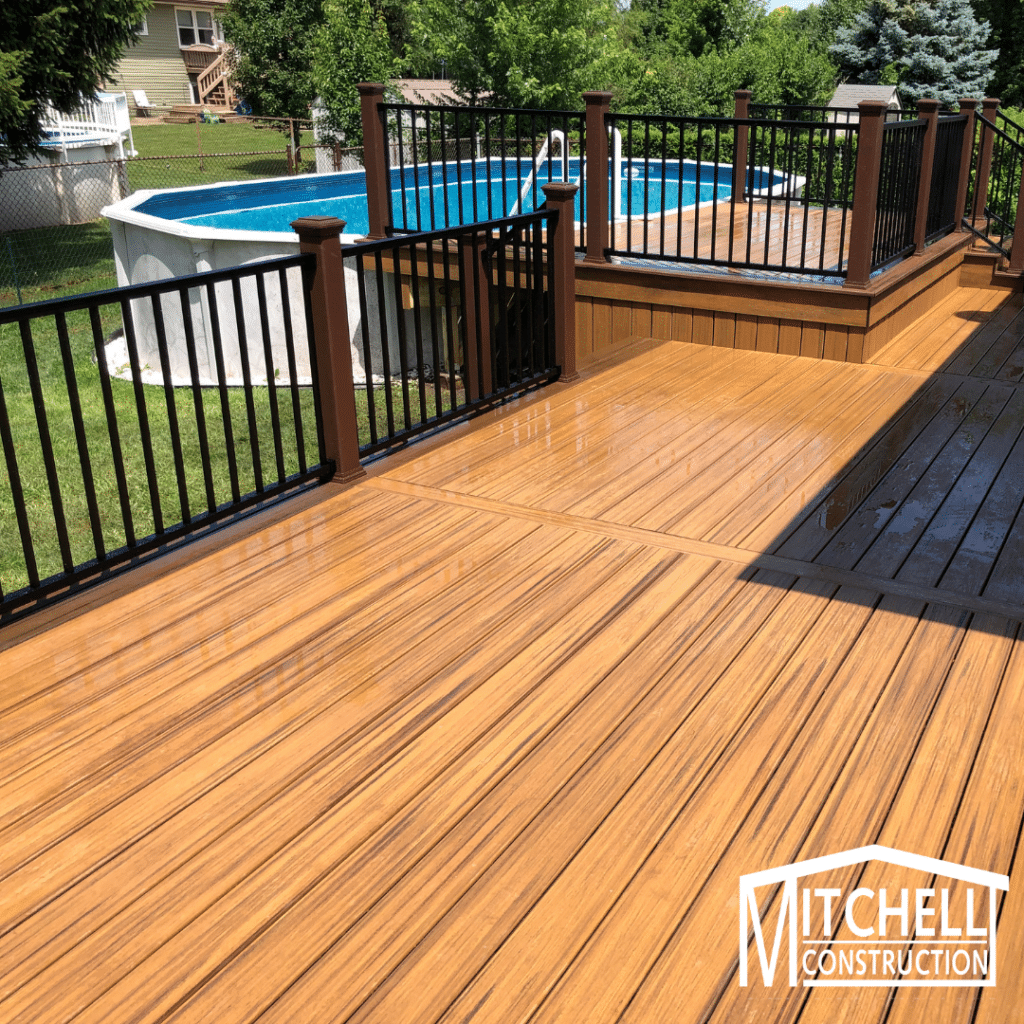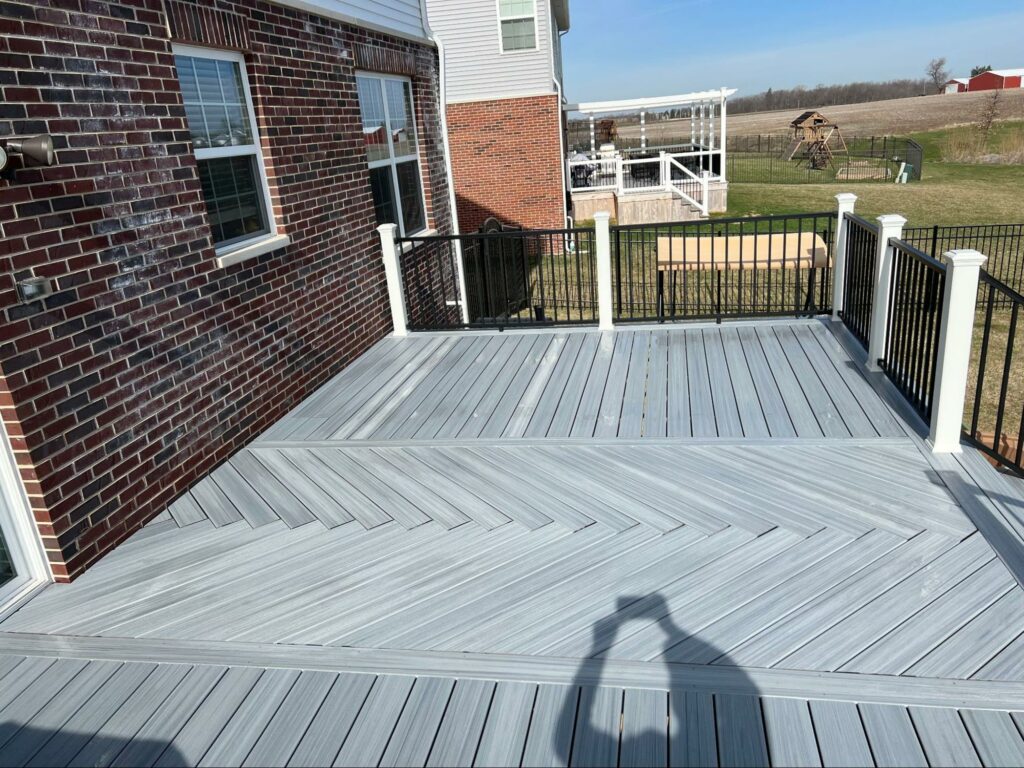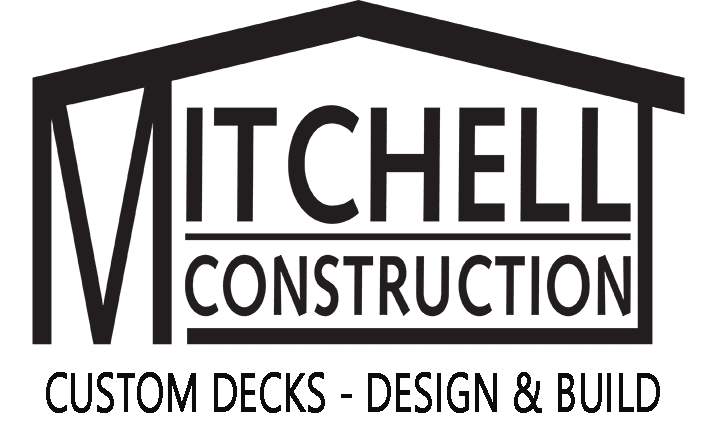If you’ve chosen a wooden decking surface, it’s only a matter of time before it loses its original beauty. One of the best ways to bring it back is through composite deck resurfacing. But when is the right time to consider this option for revitalizing your deck?
What is Deck Resurfacing?

Resurfacing involves removing the old surface of your deck, including the decking and railings, and replacing them with new ones.
The framing components— like the joists, beams, and posts—are left intact if they are still sturdy. The result is a brand-new deck surface that looks—and performs—just like new.
How Is Deck Resurfacing Different From Deck Remodeling?
When contemplating the future of your aging deck, you have two main options:
Resurfacing: This process primarily focuses on the deck’s surface. The structure, size, and shape of the deck remain unchanged. It’s a cost-effective approach that breathes new life into your deck without altering its foundational elements.
Remodeling: Remodeling offers a far greater degree of flexibility and customization, allowing you to expand your deck, add platforms and roofs, and change the layout of the space. Unlike resurfacing, remodeling can involve modifying or replacing the entire structure.
Unfortunately, in some cases, a deck may not be suitable for a resurface – such as when the structure has a short expected lifespan. In such cases, a complete deck remodel might be the only option you have left.
Is Your Deck An Ideal Candidate For Composite Deck Resurfacing?
Deck resurfacing is indeed a tempting option, as it is usually the most cost-effective, especially if you don’t need any major modifications to your deck design. But is your deck in good enough condition to be resurfaced?
- Structural Soundness is Key:
Take a look at your deck’s frame. The foundation, including the joists, beams, posts, and ledger board, should be your primary concern. If these foundational elements are showing signs of rot, warping, or any other compromise, resurfacing might just be a short-term solution. In such cases, a complete remodel might be in order. And while you might trust your judgment, there’s no substitute for a professional’s keen eye. So, before making any decisions, get an expert to give your deck a thorough inspection. - Consider the Deck’s Age:
Age isn’t just a number when it comes to decks. If your deck has been standing tall for 15-20 years, it might have stories to tell and issues to address. Older decks often have underlying problems, making them less ideal candidates for a composite resurface. - Consider the Framing Material:
Was the deck structure made with untreated or high-quality pressure-treated wood? Untreated lumber often deteriorates by the time the decking needs replacement. - Surface Wear & Tear or Structural Issues?
If the main issues with your deck are superficial, such as fading, splintering, or minor warping of the boards, then resurfacing can be an excellent solution. However, if there are more significant problems like rot or insect damage, you might need more extensive repairs or a complete remodel. - Weighing the Costs:
While deck resurfacing might sound financially appealing, sometimes the costs can sneak up on you, rivaling that of a complete rebuild. It’s essential to play the long game here. Think about the expected longevity of your current frame and future maintenance costs, and weigh them against the costs of a complete remodel. Let’s discuss this point further.
Deck Resurfacing Costs: Is Resurfacing Always the Economical Choice?
At first glance, the cost to resurface a deck with composite materials might seem like an affordable choice over remodeling. After all, you’re primarily updating the surface, leaving the structural elements untouched.
However, if the frame of your deck is nearing the end of its lifespan, resurfacing could lead to higher costs in the long run. Why? Because the frame could give out long before the new decking does. This means you’ll be faced with the costs of a complete deck remodel sooner than anticipated.
To put it simply: resurfacing is only more cost-effective in the long term if your deck structure is in good condition.
Maximizing Your Investment:
For maximum cost-effectiveness, ensure the deck’s foundation can last as long as the new composite decking.
For example, if you choose a high-quality composite like Trex, which has a durability of 25+ years, it’s essential to ensure that your deck’s foundation can match that longevity. If your deck’s structure is only expected to last another 10-15 years, then your new composite decking might not deliver its full value.
From a cost perspective, composite deck resurfacing is an ideal option if your deck’s structure has an expected lifespan of 20+ years.
Conclusion

In the end, the decision to resurface or remodel mainly depends on the condition of your deck.
While this article can serve as a guide in helping you get an idea of whether your deck is suitable for resurfacing, getting your deck inspected by a professional should be your next step. This will give you a better understanding of your deck’s expected lifespan.
Do you live in Chicago’s suburbs? The Mitchell Construction Custom Decks team is ready to help. Request an estimate today, and let’s bring life back to your deck.


